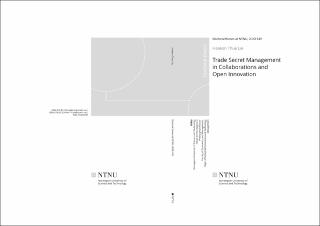| dc.contributor.author | Lie, Haakon Thue | |
| dc.date.accessioned | 2020-05-07T06:07:21Z | |
| dc.date.available | 2020-05-07T06:07:21Z | |
| dc.date.issued | 2020 | |
| dc.identifier.isbn | 978-82-326-4647-0 | |
| dc.identifier.issn | 1503-8181 | |
| dc.identifier.uri | https://hdl.handle.net/11250/2653541 | |
| dc.description.abstract | Trade secrets are secrets with commercial value that are delimited and managed. They may concern technology, business strategy, customer data and any information of value to a business that is intentionally concealed. Recently the EU, Norway and the USA amended the legal framework for trade secrets. The changes concern how trade secrets can be objects for licencing and knowledge-sharing, as parts of collaborations and open innovation.
Trade secrets need management from their creation to their end. The management needs are different from those for other intellectual property that can be published. When trade secrets are part of the knowledge flow in collaborations and open innovation, there is a need for managers to balance openness and secrecy. This thesis, with five papers, research that balance and how trade secrets are managed.
The first three papers discuss openness and access to research results from collaborative projects between universities and industry. The studies build on the analysis of the contractual agreements in 483 research projects. The results comprise a framework that can help unravel the complicated contractual provisions and their interrelationships, as well as new perspectives on lead time advantages.
The fourth paper investigates how SMEs use trade secrets to create competitive advantages from knowledge exchange and open innovation. This paper builds on survey data from 3871 Norwegian SMEs with a novel set of questions that include differentiation between establishing and using trade secrets. The paper also proposes how to set a baseline for future studies on the effect of the new legislation.
The fifth paper concerns teaching and learning trade secret management. The threshold concepts framework is an educational lens well suited for teaching subjects that are transformative and troublesome, as trade secret management is.
Trade secrets are part of the broader concept of appropriation mechanism. For researchers, it is crucial to understand better the shift from trade secrets for keeping knowledge secluded, to trade secrets used for knowledge transfer in open innovation. There is then no dichotomy of openness and secrecy. There is a process of knowledge appropriation where trade secrets blend with other mechanisms for the management of innovation. | en_US |
| dc.language.iso | eng | en_US |
| dc.publisher | NTNU | en_US |
| dc.relation.ispartofseries | Doctoral theses at NTNU;2020:149 | |
| dc.relation.haspart | Paper 1: Egelie, Knut Jørgen; Lie, Haakon Thue; Grimpe, Christoph; Sørheim, Roger. Access and openness in biotechnology research collaborations between universities and industry. Nature Biotechnology 2019 ;Volum 37.(12) s. 1413-1419
https://doi.org/10.1038/s41587-019-0324-7 | en_US |
| dc.relation.haspart | Paper 2:
Lie HT; Egelie KJ.
A New Advantage: Trade Secrets, Academic Secrets and Lead Time Advantages in Collaborative Research between Universities and Industry | en_US |
| dc.relation.haspart | Paper 3:
Egelie, KJ; Grimpe,C; Sørheim, R.
Monopoly spotting – an empirical study of research collaborations between universities and industry Lie HT, | en_US |
| dc.relation.haspart | Paper 4:
Lie, Haakon Thue; Hansen, Tor Borgar; Tobro, Marte. Trade Secret Management in SMEs. | en_US |
| dc.relation.haspart | Paper 5:
Lie, HT; Hokstad, LM; O’Connell, D.
Teaching Trade Secret Management with Threshold Concepts | en_US |
| dc.title | Trade Secret Management in Collaborations and Open Innovation | en_US |
| dc.type | Doctoral thesis | en_US |
| dc.subject.nsi | VDP::Social science: 200::Economics: 210 | en_US |
